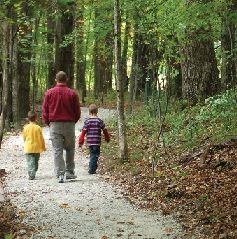
Program Accomplishments
For the LWCF Grants program, over $3.6 billion have been appropriated to the 50 States, the District of Columbia, Puerto Rico, Guam, the Virgin Islands, American Samoa, and the Northern Marianas for planning, acquisition and development of outdoor recreation opportunities in the United States. Through FY 2006, over 40,000 projects have been approved to support acquisition of open space for park lands or the development of outdoor recreation facilities. They are in every geographic region of the U.S, in every county, and almost all localities.
Federal grant obligations totaling $3.6 billion have been matched by State and local contributions, for a total LWCF grant investment of $7.2 billion. States have received about 8,300 grants and counties some 5,300 while cities, towns and other local agencies matched more 26,000.
Of the total number of projects, about 10,500 have helped states and localities to acquire some 2.6 million acres of park land, including combination projects where donated land values matched the cost of development. Almost 29,000 projects have been for the development of outdoor recreation facilities. Seventy-five percent of the total funds obligated have gone to locally sponsored projects to provide close-to-home recreation opportunities that are readily accessible to America's youth, adults, senior citizens and the physically or mentally challenged. In addition to thousands of smaller recreation areas, grants have helped to acquire and develop new parks of statewide or national significance such as the Allagash Wilderness Waterway (Maine), Liberty State Park (New Jersey), the Willamette Greenway (Oregon), Platte River park (Denver), Herman Brown Park (Houston), and Illinois Beach State Park (Chicago).
Legacies of the Grant Program
From a historical perspective, LWCF grants have contributed greatly to the outdoor recreation estate over the past 33 years. It is significant that a considerable amount of the income going to the Fund has come about through the leasing of offshore oil rights, thus recycling an important natural resource back to public use. While one resource is being used another is being protected.
In addition to the large number of projects, LWCF grants have had substantial long-term effects on the country's overall attitudes and policies toward outdoor recreation. The first legacy of this kind is the notion, basic to the LWCF Act, that States must assume a leadership role as providers of recreation opportunities.
Today, there is clear evidence that the grant program has been successful in encouraging States to take greater responsibility for the protection and development of recreation resources at every level.
The results of State leadership extend beyond simple increases in the size and number of recreation areas. Among other things, they include State actions to establish their own scenic river and recreational trail systems, to recognize the value of recreation resources in stimulating tourism and other economic opportunities, and to provide additional financial and technical assistance to local recreation efforts through State planning, grant, and loan programs. Maryland, for example, has its Program Open Space to acquire key parklands; Texas and Minnesota have dedicated portions of their cigarette taxes to support state and local recreation programs;New Jersey has a Green Acres program that provides loans as well as grants for local acquisition, rehabilitation and development.
Second, when the Fund was established, State recreation planning was essentially non-existent. Statewide recreation planning has come a long way in 30 years, and has given States and their citizens new tools to analyze recreation needs and alternatives in a systematic and responsive way. Indeed, many states now require that local governments develop recreation plans as a condition for any type of Federal or State recreation assistance.
The third legacy, and the one with the greatest impact on long-term protection of recreation resources, is the provision of Section 6(f)(3) of the Act that requires all property acquired or developed with LWCF assistance be maintained perpetually in public outdoor recreation use. Consistent enforcement over the years has ensured permanency of LWCF's contributions to the national recreation estate. The most tangible evidence of the program in future years will be the tens of thousands of recreation sites across the country that remain available for our children and our grandchildren.
In conclusion, the Land and Water Conservation Fund program is building a permanent legacy for future generations. The source of this legacy will not always be obvious to the millions of Americans, old and young, who want places to hike in the woods, swim, play ball, watch wildlife, picnic, sit under a tree, chase a pigeon or walk the dog.
But the thousands of recreation lands and opportunities created and protected by the Land and Water Conservation Fund Act will remain as perpetual monuments to the foresight of its authors and the American people.
Last updated: June 26, 2015
